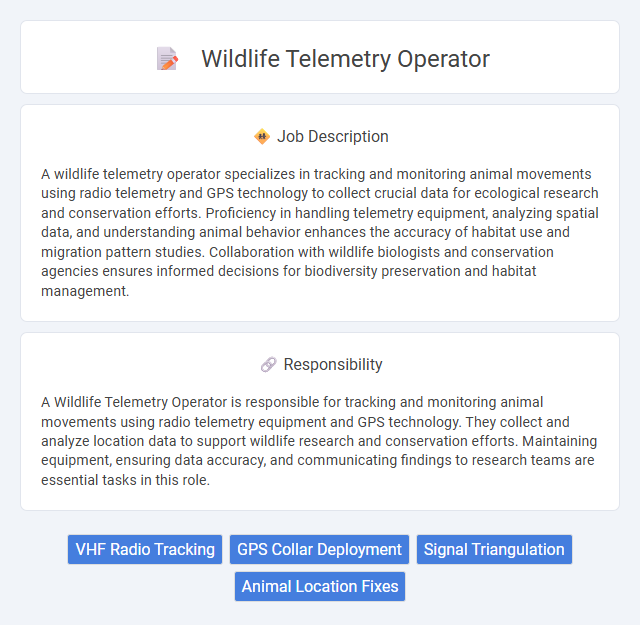
A wildlife telemetry operator specializes in tracking and monitoring animal movements using radio telemetry and GPS technology to collect crucial data for ecological research and conservation efforts. Proficiency in handling telemetry equipment, analyzing spatial data, and understanding animal behavior enhances the accuracy of habitat use and migration pattern studies. Collaboration with wildlife biologists and conservation agencies ensures informed decisions for biodiversity preservation and habitat management.
People who enjoy working outdoors and have strong observational skills will likely be well-suited for a wildlife telemetry operator job. Those comfortable with technology and data collection might find the role engaging, yet individuals who prefer stable indoor environments may struggle with its demands. Physical fitness and patience could be important, given the need for tracking and monitoring wildlife in diverse and sometimes challenging conditions.
Qualification
Wildlife telemetry operators require proficiency in radio telemetry equipment and GPS technology to accurately track and monitor animal movements. A background in biology, ecology, or environmental science is essential, often supported by fieldwork experience and knowledge of species behavior. Strong data analysis skills and the ability to troubleshoot electronic devices enhance job performance in remote and challenging environments.
Responsibility
A Wildlife Telemetry Operator is responsible for tracking and monitoring animal movements using radio telemetry equipment and GPS technology. They collect and analyze location data to support wildlife research and conservation efforts. Maintaining equipment, ensuring data accuracy, and communicating findings to research teams are essential tasks in this role.
Benefit
Working as a wildlife telemetry operator likely offers benefits such as gaining hands-on experience in tracking and monitoring animal movements, which could enhance expertise in conservation and research methods. The role might provide opportunities to work outdoors in diverse natural environments, potentially increasing job satisfaction for those passionate about wildlife. There is a reasonable probability that operators receive specialized training and collaborate with scientific teams, contributing to important ecological data collection.
Challenge
Wildlife telemetry operators likely face challenges in accurately tracking elusive animals across difficult terrains, where signal interference or environmental factors may affect data collection. The probability of encountering technical malfunctions or requiring rapid adjustments to equipment settings is relatively high, demanding strong problem-solving skills. Operators probably need to balance meticulous data recording with real-time decision-making under unpredictable conditions.
Career Advancement
Wildlife telemetry operators specialize in tracking and monitoring animal movements using advanced GPS and radio frequency technologies, providing critical data for conservation efforts. Career advancement opportunities include transitioning into wildlife biologist, environmental consultant, or research coordinator roles, where technical expertise and field experience are highly valued. Gaining certifications in GIS mapping, data analysis, and wildlife management significantly enhances prospects for leadership positions and specialized project roles within environmental organizations.
Key Terms
VHF Radio Tracking
Wildlife telemetry operators specializing in VHF radio tracking use specialized radio transmitters and receivers to monitor animal movements and behavior in their natural habitats. They deploy VHF radio collars or tags on wildlife to collect critical data on migration patterns, habitat use, and survival rates. Expertise in signal triangulation and data analysis is essential for accurate tracking and conservation research.
GPS Collar Deployment
Wildlife telemetry operators specialize in GPS collar deployment to track animal movements and monitor behavioral patterns. They manage advanced GPS tracking devices by securely fitting collars onto various wildlife species, ensuring data accuracy for research and conservation projects. Proficiency in handling electronic telemetry equipment and analyzing geospatial data is essential for optimizing wildlife management strategies.
Signal Triangulation
A Wildlife telemetry operator specializes in tracking animal movements using signal triangulation techniques, which involve measuring radio signal bearings from multiple locations to accurately pinpoint wildlife positions. Proficiency in interpreting radio telemetry frequencies and employing GPS mapping software enhances data precision and supports effective habitat monitoring. This role requires knowledge of antenna calibration, signal strength analysis, and environmental factors that impact radio transmissions.
Animal Location Fixes
Wildlife telemetry operators specialize in tracking animal location fixes using GPS and radio telemetry technology to monitor movement patterns and habitat use. They analyze data from collars or tags attached to animals, providing critical information for conservation efforts and behavior studies. Accurate location fixes support population management, migration tracking, and ecological impact assessments.
 kuljobs.com
kuljobs.com